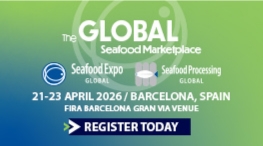This article was featured in Eurofish Magazine 5 2025.
The Federation of European Aquaculture Producers, FEAP, promotes the responsible development of the aquaculture sector, uniting European associations that represent fish farming. The mission of the organisation is to coordinate its national member associations’ positions and provide accurate information to inform policy decisions.
Lara Barazi, the first female president of FEAP, has served as the organisation’s vice president since 2018. In her new role, she headlines FEAP’s engagement with member associations and EU institutions. Here she discusses FEAP’s role in navigating new environmental pressures and regulation standards, focusing on the organisation’s position on collaboration and unification across marine sectors.
In a rapidly evolving global landscape marked by environmental, economic, and geopolitical challenges, how is FEAP navigating these complex pressures?
The pressures facing aquaculture today are profound, from climate change and inflation to geopolitical instability and increasing regulatory demands. As FEAP, our job is to help producers navigate this uncertainty by being both a credible voice and a practical partner at the European level. First, on the environmental front, climate change is not a distant threat; it’s already impacting water temperatures, fish health, extreme weather events, and even algal blooms. FEAP works closely with EU institutions, researchers, and industry to push for climate adaptation strategies that are tailored to aquaculture, while also supporting innovation in areas like selective breeding, health management, and more sustainable feed. On the economic side, producers experience growing pressure from inflation, rising input costs, and in some cases unfair competition from third-country imports. FEAP actively advocates for a level playing field, calling for better enforcement of environmental and social standards in international trade, and for greater recognition of the high standards our producers already meet in Europe. Geopolitical tensions, including war and instability in neighbouring regions, have disrupted supply chains, energy prices, and logistics. These shocks have revealed how vulnerable food systems can be. That is why FEAP is pushing for European aquaculture to be recognised as a strategic sector, one that can strengthen food security and reduce dependency on external sources of protein.
Among the many difficulties facing the sector, what priorities are you focusing on to ensure that European aquaculture remains resilient, competitive, and sustainable?
At FEAP, we’re very clear on our priorities because the challenges are real, but so are the opportunities. To ensure that European aquaculture remains resilient, competitive, and sustainable, we’re focusing on three strategic pillars: regulatory reform, climate adaptation, and fair market conditions. First, we are pushing hard for a more efficient and enabling regulatory framework. Licensing in many countries is slow, complex, and unpredictable, it’s a major bottleneck to innovation and growth. We work with the European Commission and national authorities to streamline procedures, reduce administrative burdens, and support digitalisation, while maintaining our high environmental and welfare standards. Second, we are prioritising climate change adaptation. European producers are already facing rising temperatures, extreme weather, and new disease pressures. FEAP advocates for investment in innovation, from selective breeding and improved health strategies to low-impact technologies and infrastructure upgrades, so that aquaculture can thrive under changing conditions. Third, we’re focused on securing fair and competitive market conditions. European aquaculture operates under some of the highest standards in the world, and this must be recognised and defended. That means stronger controls on imported products, clearer labelling and traceability, and ensuring that sustainability is not just a burden for EU producers but a level playing field for all.
Aquaculture in the European Union has experienced little to no growth over the past 25 years. From your perspective, what are the core reasons behind this stagnation, and what structural or policy changes are most urgently needed to unlock the sector’s full potential and reverse this trend?
This is one of the most critical questions we face as a sector, and unfortunately, it’s not a new one. The first and most fundamental barrier is the complexity and rigidity of the regulatory environment. Aquaculture in Europe is subject to overlapping national and EU regulations, lengthy and uncertain licensing procedures, and often contradictory policy goals. This creates risk and discourages investment. Second, there has been a lack of political ownership and strategic prioritisation. While aquaculture is recognised on paper as a key sector for food security and the Green Deal, that recognition has not consistently translated into concrete support or integrated policy. In some member states, aquaculture falls between ministries or lacks a clear development mandate. That needs to change, aquaculture must be treated as a strategic food-producing sector, not an afterthought. Third, negative narratives, often outdated or not based on facts, have influenced public opinion and, in turn, policy decisions. We need a more proactive, science-based communication strategy that explains the benefits of European aquaculture: its low carbon footprint, its contribution to coastal communities, and its role in sustainable food systems.
Climate change is rapidly altering the operating environment for fish farmers across Europe. What are the most urgent regulatory and infrastructural changes needed to enable aquaculture to remain resilient under these conditions?
On the regulatory side, the first step is to ensure that climate adaptation is fully integrated into national aquaculture strategies, marine spatial planning, and EU-level frameworks like the Strategic Guidelines for EU Aquaculture and the Nature Restoration Law. We need regulations that are flexible, science-based, and forward-looking, allowing producers to innovate, relocate, or modify operations in response to changing environmental conditions. For example, permitting procedures must allow for timely upgrades to infrastructure, adoption of new farming technologies, and movement of sites if climate conditions make existing areas unviable. Too often, rigid regulations and slow authorisations become a barrier to adaptation, precisely when agility is needed most. On the infrastructural side, investment is critical. We urgently need targeted funding, particularly through instruments like the EMFAF, to support: Modernisation of farms to cope with temperature extremes and water quality fluctuations, selective breeding programs for climate-resilient species and strains, offshore and integrated production systems that can withstand more variable and energetic environments, and data collection and digital monitoring tools to better anticipate and manage climate risks.
As the first female president of FEAP, how has your experience shaped your perspective on gender and diversity in the industry? And what are your priorities for making aquaculture more inclusive?
It’s an honour to serve as FEAP’s first female president, and I see it not just as a personal milestone, but as a sign that the industry is evolving. Aquaculture has traditionally been male-dominated, particularly at senior leadership levels, but I believe that is starting to change, and it must change if we want the sector to be dynamic, innovative, and future-ready. I’ve seen first-hand how women contribute across the value chain, from hatcheries and farms to labs, marketing, and management, often with enormous dedication, resilience, and skill. At FEAP, we embed this thinking into all our work promoting visibility and leadership opportunities for women in aquaculture, not only through representation but also through mentorship, networks, and speaking platforms. We have organised a couple of one-week-long training sessions for young women aquaculture professionals in collaboration with the General Fisheries Commission for the Mediterranean and Black Sea (GFCM-FAO). We are also supporting young professionals through engagement with universities, training programs, and industry-academia partnerships, ensuring they see aquaculture as a viable, forward-looking career path; championing inclusive hiring and skills development.
According to the recent Special Eurobarometer SP558 on EU consumer habits regarding fishery and aquaculture products, public awareness and trust in farmed fish remain uneven across Member States. What specific actions or communication campaigns is FEAP undertaking to improve public understanding?
The findings of Special Eurobarometer 558 confirm what many of us in the sector have known for some time: public perception remains one of the biggest barriers to the growth of sustainable aquaculture in Europe. While many consumers are open to farmed fish, awareness is uneven, and persistent myths, about quality, welfare, or environmental impact, continue to shape attitudes and consumption choices. At FEAP, we believe that building consumer trust is not just a communications issue, it’s a strategic priority for the entire sector. FEAP is actively involved in shaping and supporting coordinated EU-wide messaging about aquaculture. We are working closely with the European Commission, particularly under the Common Market Organisation (CMO), to promote facts, not myths, and to highlight the nutritional, environmental, and economic benefits of farmed fish. We are also strong advocates for clearer, more informative labelling of aquaculture products across the EU. Consumers have a right to know where their fish comes from, how it was produced, and under what standards. By improving traceability and emphasising EU-origin products, we can reinforce the message that European aquaculture is not only sustainable, it is also trustworthy. Additionally, we believe that when consumers understand the reality of farmed fish, the quality, care, and science behind it, trust will follow. FEAP is committed to making that happen.
As a pan-European organisation, how does FEAP ensure that the perspectives and needs of all its members are equally represented and reflected in its policy work and advocacy, and it does it work to foster cohesion across its members?
The diversity of European aquaculture is both a strength and a challenge. At FEAP, we represent producers from across the continent, from large-scale salmon operations in the North to small family-run carp ponds in Central Europe, and marine cage farms for bass and bream in the Mediterranean. Each country and production system comes with its own realities, priorities, and pressures, whether they relate to environmental conditions, regulatory frameworks, market access, or public perception. FEAP operates on the principle of consensus. Before taking public positions or engaging with EU institutions, FEAP consults its full membership to find common ground. This collaborative approach ensures that no single region, species, or interest dominates the narrative. Regular General Assemblies, technical meetings, and digital consultations allow members to voice concerns and propose priorities. These forums foster mutual understanding between regions that might otherwise be disconnected, for instance, between coldwater and warmwater producers or between large-scale and small-scale operators. Additionally, from environmental regulation to market disruptions or animal welfare standards, FEAP actively tracks how emerging issues affect producers differently across the continent. This allows it to respond with informed and inclusive policy positions that acknowledge both common challenges and
regional variation.
Looking toward the future, what are your key strategic priorities for FEAP over the next five years? And personally, what impact or legacy would you most like to leave from your tenure as president of the organisation?
Looking ahead, my key strategic priority for FEAP is to position aquaculture as a core pillar of Europe’s sustainable food system. That means ensuring that our sector is not only heard, but truly integrated into major EU strategies, from climate adaptation and food security to rural development and ocean restoration. Over the next five years, FEAP will focus on securing structural reform that unlock growth particularly in licensing, championing climate adaption and innovation, defending fair market conditions, driving generational renewal, and promoting cohesion and unit across our diverse membership. On a personal level, the legacy I hope to leave is twofold. First, I would like to be remembered for making FEAP more open, inclusive, innovative and future-facing, a platform that brings in new voices, champions diversity, and reflects the full energy of the sector. Second, I would like to be remembered for helping to transform FEAP into a more professional, transparent, and effective organisation, with strengthened governance, clearer structures, and more strategic engagement at the EU level. FEAP must continue evolving to meet the demands of a rapidly changing sector, and that means operating with the same level of professionalism and accountability we expect from ourselves as farmers.









